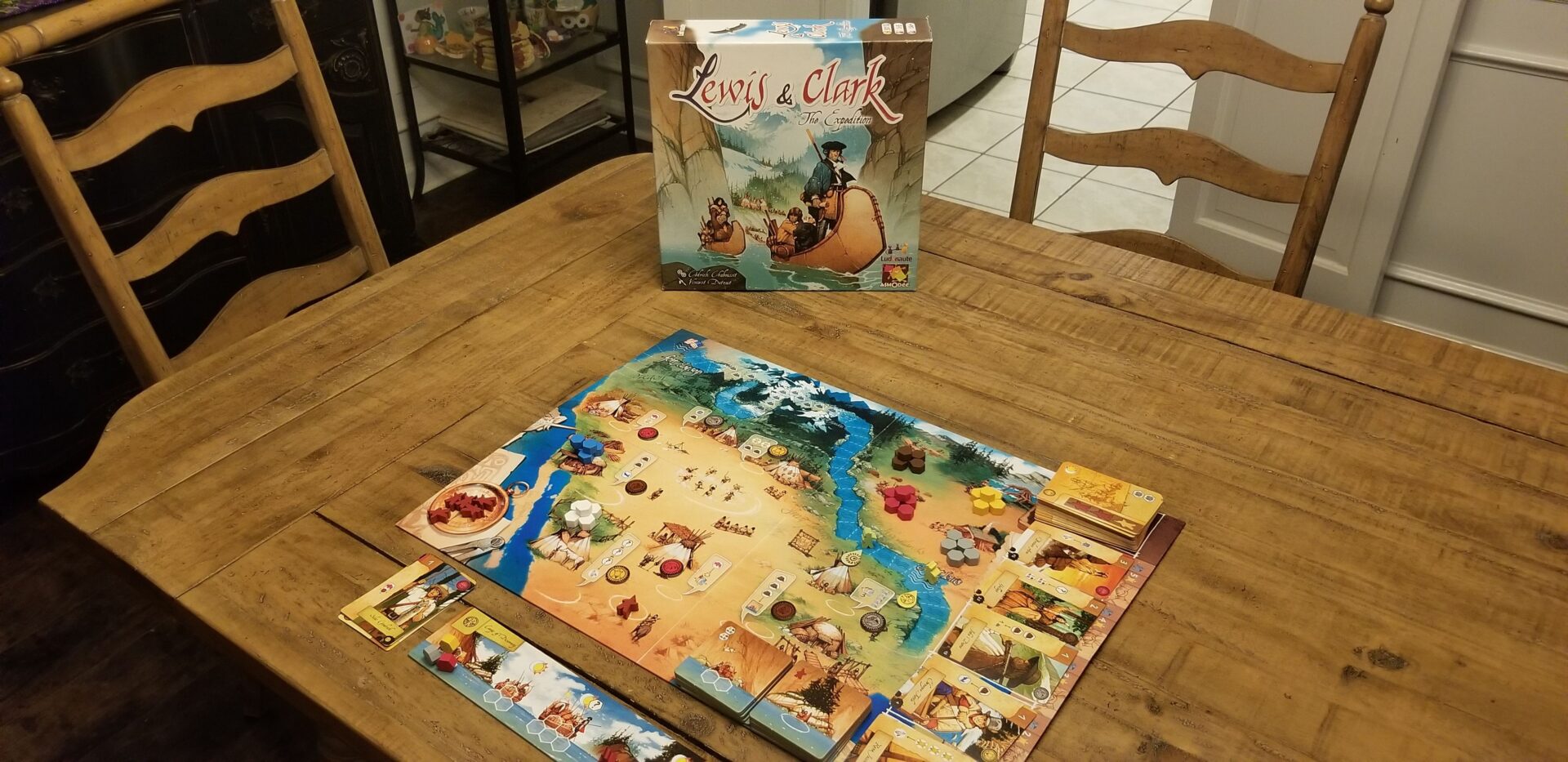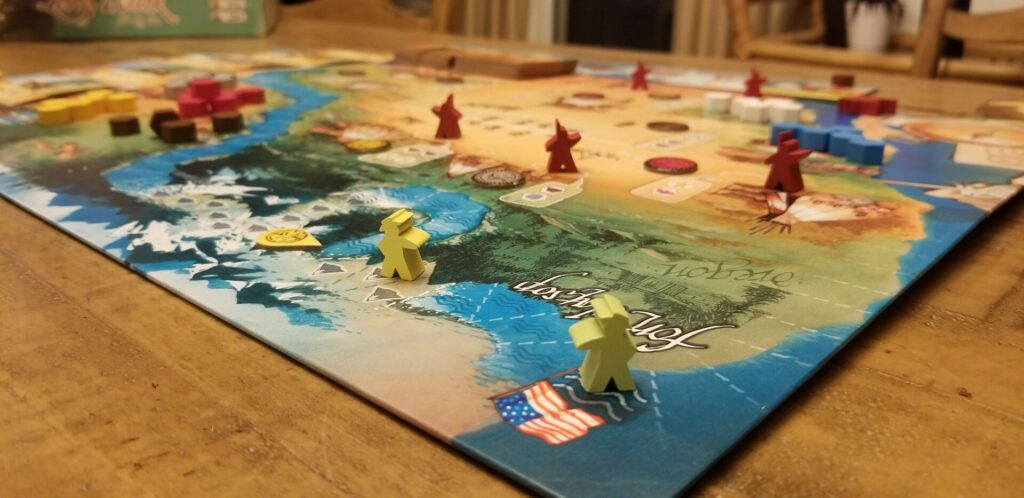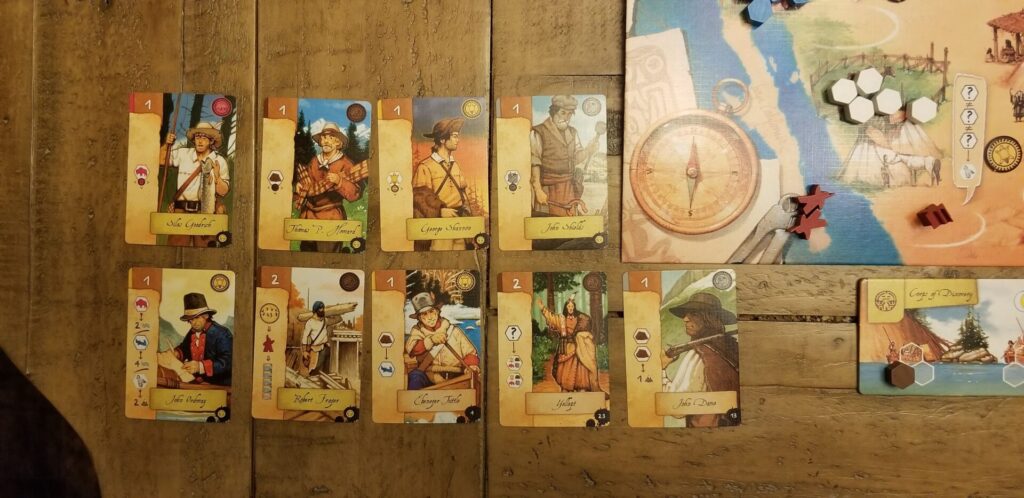
Name: Lewis & Clark – The Expedition (First Edition)
Year of Release: 2013
Player Count: 1 – 5 Players
Playing Time: 120 minutes
Designer: Cedrick Chaboussit
Publisher: Asmodee
Primary Mechanisms: Race, Hand Management, Worker Placement, Deck Building
Weight (According to boardgamegeek.com): 3.34
Overview
The year is 1804 and my name is John Ordway, one of the commanders of the Corps of Discovery. Our mission is to leave St. Louis, travelling up the Missouri river, searching for a waterway that will connect the east and the west of the Louisiana Territory. With me, I have Robert Frazer as an interpreter to the Native Americans we suspect to encounter on our way; a lumberjack by the name of Thomas Howard; Silas Goodrich whose sole job is to keep us fed; a blacksmith and gunsmith by the name of John Shields, and lastly our fur trader, George Shannon. We are ready to set sail up the river today and hopefully inscribe our names in the annals of history, but we’ve heard a Scottish explorer, Alexander Mackenzie, has already started his journey up the river, attempting to beat us to our prized possession. Let the race begin!
Setup and Components

Lewis & Clark: The Expedition is by far the most historical board game I own. As you probably gathered from my introduction, you take charge of an expedition to be the first to cross the newly purchased Louisiana Territory. But before any journey can begin, there is some minor setup to be had and thankfully in Lewis & Clark, it is light.
The game really doesn’t include a lot in the box and honestly the storage container could have been pared down quite a bit. You have one main board to put out and then a few small player boards that will help you take care of your resources and your Native American helpers. Speaking of the Native American helpers, you get some Indian Meeples that you put out, based on the number of players in the game. For our solo purposes today, we would put out 6 to use throughout the game. There are a few colored meeples that act as your expedition’s scout and you place yours on the St. Louis starting spot. For the AI Player (named Alexander Mackenzie) you will also place his meeple out but first you have to decide what difficulty you’d like to play at. He can either start at 0 with you (easy level) or can start up to 7 spaces ahead (expert level.) I played my game with Mackenzie starting 3 spaces ahead.
There are also quite a few colored hexagon resource tokens you place out. I like that these have wildly different colors so they will never get confused on the table. You have a “pink-ish red” that serves as a food resource, a brown to serve as wood, a grey for equipment, and a yellow for fur. These are your four main resources. In addition, there is a blue resource for canoes and a white resource for horses. The latter two will be your main modes of travel up the river and through the mountains ahead.
Lastly, you need to prepare your deck of character cards. There are 5 different starting decks depending on which color meeple you’re using. These starting decks all contain 6 cards with 6 different actions but each starting deck is the exact same as the next. The one difference though is that the characters themselves are all different and based on real people who had something to do with Lewis and Clark’s actual journey. Outside of the 5 starting decks, there is a large deck of 54 “encountered characters” who represent people you can recruit throughout your travels. Again, all of these cards are modeled after real historical figures. If you’re a history buff, you’ll love that there is a whole section in the instruction manual dedicated to giving you some information on each of these figures (84 in total.) That’s basically it for the setup, so let’s talk about the gameplay.
Gameplay

This game holds a special place in my collection because of how effortlessly it flows, even with a multitude of mechanics. The two main mechanics in the game are the deck-building aspect (with recruiting new cards as you travel) and then the worker placement aspect with the Native American meeples. You have to strike a smart balance between the two as they work together to feed your engine and keep you moving toward your target.
Your turn essentially boils down to two decisions, whether to play a card or send out your Native American meeples to do some work for you. When you play a card, you must power that action with another card or a meeple, or a combination of both if you’re trying to activate the action more than once. This adds a nice dimension where you might have cards that aren’t helpful yet so you use them to power other cards but you know that they will be able to shine when the time comes. The second decision revolves around the middle of the game board where there are different action spaces. You can deploy your meeples to these stations (some allowing only one meeple and some allowing more than one) and then the actions are triggered. The biggest catch with this is that you don’t automatically get these workers back at the end of the turn and/or round. There is actually a card in your hand you play that allows you to collect all (or none) of the meeples on the board and clear them from their action spaces (by plopping them all down in the middle.) This is a neat mechanic that I don’t think I’ve seen in many other worker placement games I own.
This probably all sounds relatively simple in that you play some card, or fill up some action places, and then do the required action but there is a catch; encampment. So, there are a few things happening while you’re taking your actions. The first is that you’re playing cards down and powering them with other cards, but how do you ever get them back into your hand? Secondly, if you’re taking actions involving canoes or horses, you’re moving your meeple forward but what is the deal with that little tear drop marker (called “the camp”) way back there in St. Louis? Both of these questions are answered when you choose to take the encampment action.
When you camp, you’re basically declaring that you’re ready to “reset” your expedition but what does this mean? First, it allows you to place all your used cards back into your hand. Second, it allows you to take back any Native American meeples that you used to power those cards (but not the ones you placed into the middle of the board.) While doing these two things, you do have to pay attention to how your player board is being affected. You might end up with more meeples than what fit in the boat. You might have grabbed more resources and they are spilling out of your first boat and into your second. Or maybe you didn’t even have enough cards or meeples to power your last card so you couldn’t even play it. All of these culminate into a penalty which causes your scout to move back a certain number of spaces on the trail. Once resolved, you can take “the camp” tear drop marker and move it up the river until it meets up with your scout again.
This is my favorite part of Lewis & Clark as this mechanism makes every decision weighty. You can’t just fill up on resources or you’ll end up moving backwards more than forwards. But there are times where it’s worth it to move back a few spaces as you might be able to offload the resources or Native Americans on your next turn, chaining together multiple actions. I will concede that this can cause those players who are prone to Analysis Paralysis to go overboard trying to work out if they’ll have the exact number of everything they’ll need by encampment so they don’t have to move backwards.
The game ships with an official variant but honestly, it is sort of lackluster. I’ve mentioned the AI Player, Mackenzie. He never takes actions or even blocks you on spaces. He is there purely to move up one space each turn. Part of me yearns for a way to better simulate playing against a real player. The other part of me is sort of relieved though because I am able to solely pour my concentration into what I am doing and trying to figure out the puzzle of getting the right cards and deploying my meeples at the right time to race up the river.
Conclusion
If you can’t tell, I like this game. I probably like it more as a multiplayer game (though my wife beats me every time) but I don’t have too much heart burn against the solo version. So, lets check back in with Commander Ordway and see how him and his expedition fared on their journey up the river!
- Before pushing off in our canoes, we were able to recruit a young man by the name of Ebenezer Tuttle in St. Louis. He promises to be worth his weight in gold as he is an excellent oarsman and knows the river like the back of his hand. I hope he is telling the truth as we’ll need all the luck and experience we can get to catch up to Mackenzie.
- The expedition is already making headway, mostly thanks to Tuttle. Between himself and the lumberjack, Howard, we are making good time up the Missouri and should be overtaking Mackenzie any day now.
- Two extraordinary things happened today: a new recruit and we passed Mackenzie as he camped at Fort Mandan. Our new recruit is named John Dame. Although only 19, he promises that he will get us through the mountains that lie ahead faster than anyone else on the Missouri.
- The expedition has left the river and entered the mountains but we know Mackenzie is only a day or so behind us. Our interpreter has met with the Walla Walla chief, Yellept, who has promised to help us. He is very interested in some of the equipment we carry with us and is open to trading the natural resources for them. I’m looking forward to this new partnership.
- I’m sorry to report but John Dame is a huge disappointment! For all of his blabber about being able to trade for the best horses around and getting us through this mountain, he has only gone and got us lost. We’ve finally managed to get out of the mountain range and back to a waterway, but we suspect that Mackenzie is at least three days ahead of us.
- Unlike that damned Dame, Tuttle again pulls his weight and more and gets us through the latest waterway. We don’t believe to have gained much ground on Mackenzie but we haven’t lost any. The expedition is losing hope though as we are entering a second mountainous zone and we all know how the first one went.
- Note to self, never trust anything John Dame says again. This mountain range was worse than the last. We’ve lost multiple people to both sickness and desertion as nobody trusts Dame nor do they have much trust left in myself. I’m afraid that we will not be making it to Fort Clapsop first.
- Alas, our adventure is finally over but Mackenzie and his team arrived at the fort in Oregon 4 days ahead of us. I will be glad if I never have to set foot in those mountains of death again.
Oh no, poor Ordway! Better luck next time defeating Mackenzie and being the first team to get from St. Louis to Oregon!
Rating
Ratings are based on 5 main criteria: rulebook, setup, components, art & graphic design, and gameplay. The first 4 criteria are rated 1 to 5 and the gameplay is rated 1 to 10. These scores culminate in an “overall satisfaction” score that is rated from 1 to 10. If the reviewed game has both a solo and multiplayer mode, I have assigned scores separately to give context to which mode we enjoy more.
Links
As an Amazon Associate I earn from qualifying purchases.
